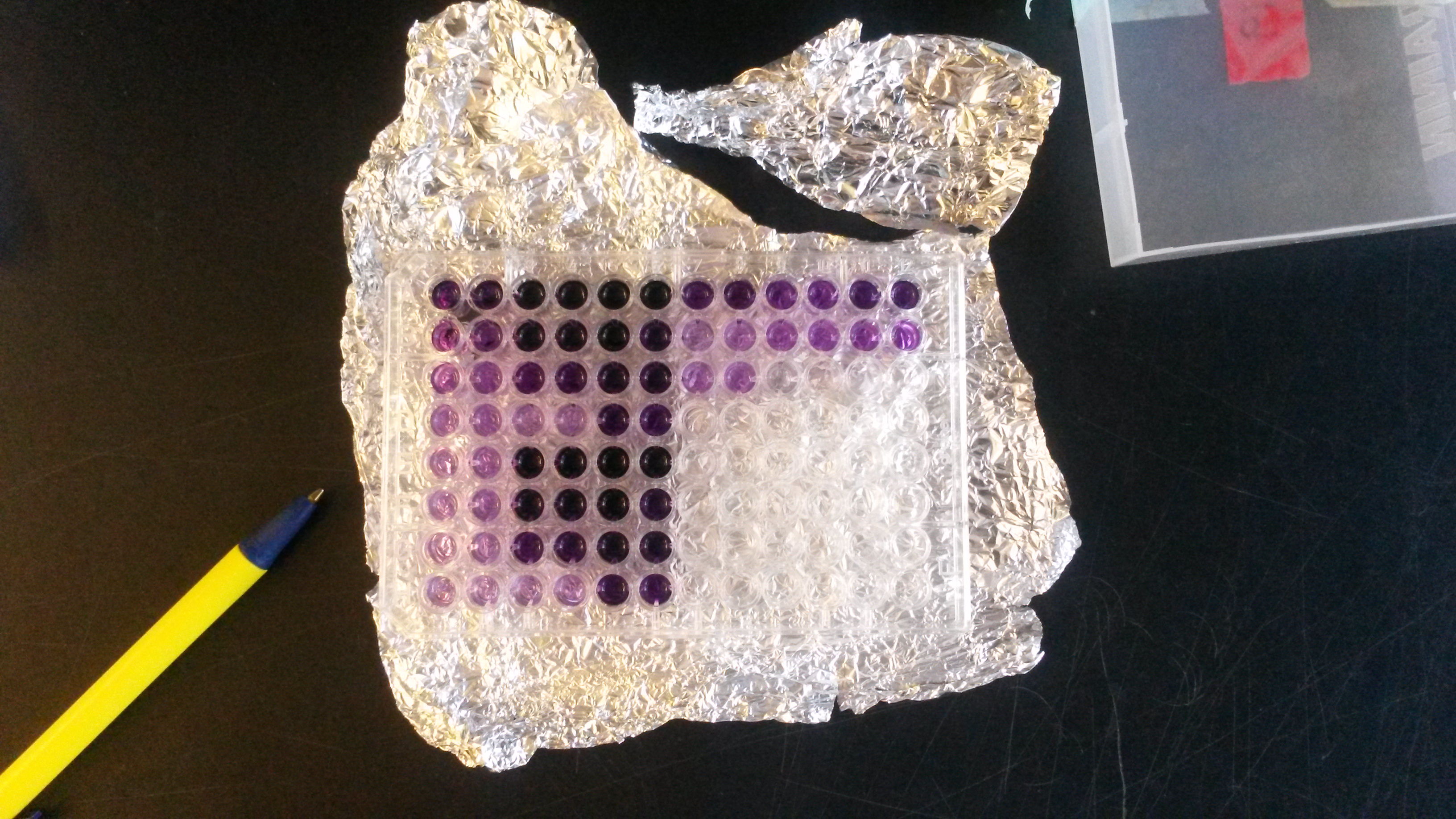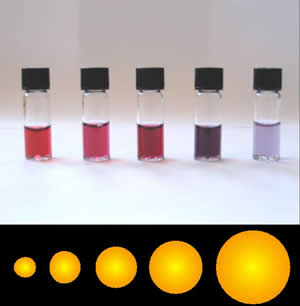|
Colloidal Gold Protein Assay
The colloidal gold protein assay is a highly sensitive biochemistry, biochemical assay for determining the total concentration of protein in a solution (~0.1 ng/μL to 200 ng/μL). It was first described in 1987 by two groups who used commercially available "Aurodye" colloidal gold solutions. Notably, the formulation of Aurodye changed between 1987 and 1990 such that it became incompatible with protein assays, however vendors such as Bio-Rad & Diversified Biotech starting offering colloidal gold formulations that were suitable for protein assays. These products have since been discontinued and there are no vendors that currently explicitly sell colloidal gold for the assay, however detailed synthetic procedures were published to produce the ~17-40 nm gold nanoparticles that are suitable for the assay, along with modifications to increase the shelf stability of the colloidal gold & adapt the assay to microplate format & increase its sensitivity. Gold nanoparticles in the ... [...More Info...] [...Related Items...] OR: [Wikipedia] [Google] [Baidu] |
Biochemistry
Biochemistry or biological chemistry is the study of chemical processes within and relating to living organisms. A sub-discipline of both chemistry and biology, biochemistry may be divided into three fields: structural biology, enzymology and metabolism. Over the last decades of the 20th century, biochemistry has become successful at explaining living processes through these three disciplines. Almost all areas of the life sciences are being uncovered and developed through biochemical methodology and research.Voet (2005), p. 3. Biochemistry focuses on understanding the chemical basis which allows biological molecules to give rise to the processes that occur within living cells and between cells, Karp (2009), p. 2. in turn relating greatly to the understanding of tissues and organs, as well as organism structure and function. Miller (2012). p. 62. Biochemistry is closely related to molecular biology, which is the study of the molecular mechanisms of biological phenom ... [...More Info...] [...Related Items...] OR: [Wikipedia] [Google] [Baidu] |
Bicinchoninic Acid Assay
The bicinchoninic acid assay (BCA assay), also known as the Smith assay, after its inventor, Paul K. Smith at the Pierce Chemical Company, now part of Thermo Fisher Scientific, is a biochemical assay for determining the total concentration of protein in a solution (0.5 μg/mL to 1.5 mg/mL), similar to Lowry protein assay, Bradford protein assay or biuret reagent. The total protein concentration is exhibited by a color change of the sample solution from green to purple in proportion to protein concentration, which can then be measured using colorimetric techniques. Mechanism A stock BCA solution contains the following ingredients in a highly alkaline solution with a pH 11.25: bicinchoninic acid, sodium carbonate, sodium bicarbonate, sodium tartrate, and copper(II) sulfate pentahydrate. The BCA assay primarily relies on two reactions. First, the peptide bonds in protein reduce Cu2+ ions from the copper(II) sulfate to Cu1+ (a temperature dependent reaction). The amou ... [...More Info...] [...Related Items...] OR: [Wikipedia] [Google] [Baidu] |
Bradford Protein Assay
The Bradford protein assay was developed by Marion M. Bradford in 1976. It is a quick and accurate spectroscopic analytical procedure used to measure the concentration of protein in a solution. The reaction is dependent on the amino acid composition of the measured proteins. Principle The Bradford assay, a colorimetric protein assay, is based on an absorbance shift of the dye Coomassie brilliant blue G-250. The Coomassie brilliant blue G-250 dye exists in three forms: anionic (blue), neutral (green), and cationic (red). Under acidic conditions, the red form of the dye is converted into its blue form, binding to the protein being assayed. If there's no protein to bind, then the solution will remain brown. The dye forms a strong, noncovalent complex with the protein's carboxyl group by van der Waals force and amino group through electrostatic interactions. During the formation of this complex, the red form of Coomassie dye first donates its free electron to the ionizable groups ... [...More Info...] [...Related Items...] OR: [Wikipedia] [Google] [Baidu] |
Colloidal Gold
Colloidal gold is a sol or colloidal suspension of nanoparticles of gold in a fluid, usually water. The colloid is usually either wine-red coloured (for spherical particles less than 100 nm) or blue/purple (for larger spherical particles or nanorods). Due to their optical, electronic, and molecular-recognition properties, gold nanoparticles are the subject of substantial research, with many potential or promised applications in a wide variety of areas, including electron microscopy, electronics, nanotechnology, materials science, and biomedicine. The properties of colloidal gold nanoparticles, and thus their potential applications, depend strongly upon their size and shape. For example, rodlike particles have both a transverse and longitudinal absorption peak, and anisotropy of the shape affects their self-assembly. History Used since ancient times as a method of staining glass colloidal gold was used in the 4th-century Lycurgus Cup, which changes color dependin ... [...More Info...] [...Related Items...] OR: [Wikipedia] [Google] [Baidu] |
EZQ Protein Assay
Derek Boland (15 January 1965 – 15 November 2009), better known by his stage name Derek B, was a British rapper. His most commercially successful releases were "Goodgroove" and "Bad Young Brother" in 1988. Biography Born in Hammersmith, London, to Trinidadian nurse Jenny Boland, he was raised in Woodford. When he was fifteen years old, he began DJing in a mobile unit around London, before joining local pirate radio stations such as Kiss FM and LWR and finally starting his own station, WBLS (not to be confused with the radio station of the same name in New York). He joined Simon Harris' Music of Life record label, as the closest thing they had to an A&R man. When a planned compilation of US hip hop called ''Def Beats 1'' (Music of Life, 1986) ran short of tracks, Boland stepped in to record a track called "Rock the Beat". He co-produced the track with Harris, rapped on it under the pseudonym EZQ, and also did his own deejaying under the name "Derek B". "Rock the Beat" (Mus ... [...More Info...] [...Related Items...] OR: [Wikipedia] [Google] [Baidu] |
(3-(2-Furoyl)-quinoline-2 Carboxaldehyde)
3-(2-Furoyl)-quinoline-2-carboxaldehyde (FQ) is a fluorogenic amine labeling dye that is not fluorescent itself, but reacts with primary amines to form fluorescent products. It was first reported in 1990. Cyanide, typically provided via KCN or NaCN salts, is a required co-substrate in the fluorogenic reaction. It has been used for the detection of amines and peptides, largely in CE-SDS, where it is recognized to reach a silver stain-like high sensitivity via laser-induced fluorescence. Once bound to protein the excitation wavelength is 480 nm (blue) and the emission wavelength is ~600 nm (orange). Reaction See also * CBQCA * Fluorescamine Fluorescamine is a spiro compound that is not fluorescent itself, but reacts with primary amines to form highly fluorescent products. It hence has been used as a reagent for the detection of amines and peptides. 1-100 µg of protein and down ... * Py-1 References Dyes Quinolines Aldehydes Furanones {{organi ... [...More Info...] [...Related Items...] OR: [Wikipedia] [Google] [Baidu] |
Sodium Dodecyl Sulfate
Sodium dodecyl sulfate (SDS) or sodium lauryl sulfate (SLS), sometimes written sodium laurilsulfate, is an organic compound with the formula . It is an anionic surfactant used in many cleaning and hygiene products. This compound is the sodium salt of the 12-carbon an organosulfate. Its hydrocarbon tail combined with a polar " headgroup" give the compound amphiphilic properties that make it useful as a detergent. SDS is also component of mixtures produced from inexpensive coconut and palm oils. SDS is a common component of many domestic cleaning, personal hygiene and cosmetic, pharmaceutical, and food products, as well as of industrial and commercial cleaning and product formulations. Physicochemical properties The critical micelle concentration (CMC) in water at 25 °C is 8.2 mM, and the aggregation number at this concentration is usually considered to be about 62. The micelle ionization fraction (α) is around 0.3 (or 30%). Applications Cleaning and hygiene SDS i ... [...More Info...] [...Related Items...] OR: [Wikipedia] [Google] [Baidu] |
Assay
An assay is an investigative (analytic) procedure in laboratory medicine, mining, pharmacology, environmental biology and molecular biology for qualitatively assessing or quantitatively measuring the presence, amount, or functional activity of a target entity. The measured entity is often called the analyte, the measurand, or the target of the assay. The analyte can be a drug, biochemical substance, chemical element or compound, or cell in an organism or organic sample. An assay usually aims to measure an analyte's intensive property and express it in the relevant measurement unit (e.g. molarity, density, functional activity in enzyme international units, degree of effect in comparison to a standard, etc.). If the assay involves exogenous reactants (the reagents), then their quantities are kept fixed (or in excess) so that the quantity and quality of the target are the only limiting factors. The difference in the assay outcome is used to deduce the unknown quality or q ... [...More Info...] [...Related Items...] OR: [Wikipedia] [Google] [Baidu] |
Thiol
In organic chemistry, a thiol (; ), or thiol derivative, is any organosulfur compound of the form , where R represents an alkyl or other organic substituent. The functional group itself is referred to as either a thiol group or a sulfhydryl group, or a sulfanyl group. Thiols are the sulfur analogue of alcohols (that is, sulfur takes the place of oxygen in the hydroxyl () group of an alcohol), and the word is a blend of "''thio-''" with "alcohol". Many thiols have strong odors resembling that of garlic or rotten eggs. Thiols are used as odorants to assist in the detection of natural gas (which in pure form is odorless), and the "smell of natural gas" is due to the smell of the thiol used as the odorant. Thiols are sometimes referred to as mercaptans () or mercapto compounds, a term introduced in 1832 by William Christopher Zeise and is derived from the Latin ('capturing mercury')''Oxford American Dictionaries'' ( Mac OS X Leopard). because the thiolate group () bonds very str ... [...More Info...] [...Related Items...] OR: [Wikipedia] [Google] [Baidu] |




